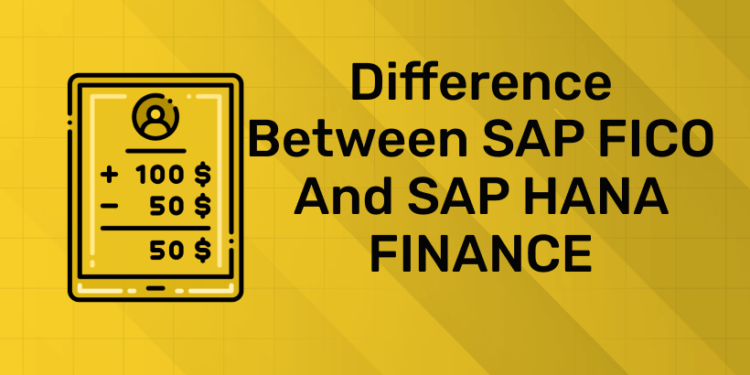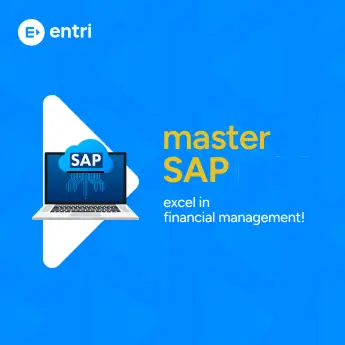Table of Contents
In the current scenario, many organizations are using idle data to improve their business performance. So, to manage customer interactions and manage business operations, SAP creates ERP systems. SAP stands for “Systems, applications and products in data processing”. Therefore, two of the most popular SAP products include SAP HANA and FICO. Here we will understand the importance of both SAP modules and how they differ from each other.
Unlock Your Accounting Potential – Enroll in Our Accounting Course!
What is SAP S/4HANA Finance?
SAP S/4HANA Finance is a financial application on the SAP S/4HANA ERP platform. It is designed to eliminate traditional barriers between trading, analytical and planning systems to provide instant insights and rapid analysis using all levels of financial data.
The product includes a set of interconnected financial management and accounting functions to process real-time data from business applications in the S/4HANA ERP system. For example, decision makers can use it to model financial scenarios and develop forecasts.
Formerly known as SAP Simple Finance, SAP S/4HANA Finance is the first ERP component or module released for S/4HANA. It is aimed at finance professionals across all industries, including CFOs and others involved in accounting, tax, treasury, financial operations, risk management and compliance. The user base ranges from small businesses to Fortune 100 companies worldwide, according to SAP.
S/4HANA Finance Architecture
SAP S/4HANA Finance is part of S/4HANA, built on SAP HANA, an in-memory database platform. By storing data in the computer’s main memory instead of on disk, in-memory databases enable faster queries and can analyze more information in a timely manner than traditional databases often serves as a repository for data from the ERP system.
With HANA at its core, S/4HANA integrates cross-organizational functions such as accounting and purchasing into a single system that combines business transaction records with analytics. The SAP S/4HANA Finance user interface is built on top of SAP Fiori, the vendor’s user experience platform. Fiori uses a simple, consumer-style tile-based design that can be viewed on a variety of desktop and mobile devices.
Universal Magazine is perhaps the most important differentiating aspect of the S/4HANA Finance architecture. It is essentially a single data table that stores all financial information in the S4/HANA system. Older ERP systems often have multiple general ledgers, each with a limited number of fields that cannot be edited. Universal Journal, on the other hand, centralizes general ledger data into a single chart of accounts, helping to unify multiple ERP systems, according to SAP.
Fields can be edited and there can be as many records as needed to collect all the data. Some companies have billions of documents in their Universal Journal. The vendor claims that Universal Journal also provides a standardized data set, which avoids the need to reconcile data and makes reporting easier.
Additionally, this feature supports machine learning, which typically requires large amounts of normalized data to “learn.” For example, S/4HANA Finance can learn about common errors users make and approve payments instead of waiting for users to complete the steps they intended.
When S/4HANA Finance is deployed on a central server, it can act as a hub for financial data from multiple systems, including different ERPs. In such cases, we talk about Central Finance. Both names are widely used and it is easy to confuse them.
Simply put, S/4HANA Finance is the financial accounting management module of S/4HANA, while Central Finance (sometimes called CFIN) is the centrally deployed S/4HANA Finance module supplemented by software integration data to connect it to other systems. To paraphrase an SAP executive, what is S/4HANA Finance and what is Central Finance?
Another architectural innovation of S/4HANA Finance is that it consolidates the separate financial accounting (FI) and control (CO) modules of pre-S/4HANA SAP ERP products. According to Oona Flanagan, author of A Practical Guide to SAP S/4HANA Financial Accounting, before S/4HANA, recording revenue or expense items was necessary to create a general ledger account in the module FI as well as the corresponding cost component in CO. In S/4HANA Finance, cost elements are recorded in the general ledger data record along with revenue elements.
Master SAP with Expert-Led Courses
Unlock your potential with our comprehensive SAP courses! Learn essential modules like SAP MM (Materials Management), SAP SD (Sales and Distribution), and SAP FICO (Financial Accounting and Controlling) from industry experts.
Know MoreWhat are the benefits and drawbacks of SAP S/4HANA Finance?
S/4HANA Finance Deployment Options
SAP S/4HANA Finance, like S/4HANA as a whole, can be deployed on-premises, in the cloud, or in a hybrid environment. However, Central Finance is only available on the private cloud, an approach that allows businesses to move to S/4HANA at their own pace with a system that can adapt as their needs change , according to SAP.
Another deployment option is the S/4HANA Finance module provided with S/4HANA Cloud, the multi-tenant SaaS version of S/4HANA. This may appeal more to organizations wanting more standardization of their finance processes, faster deployment capabilities, and access to advanced features such as AI and predictive analytics .
Migration options to S/4HANA Finance
Many organizations have used Central Finance deployment as the first step towards migrating their entire ERP system to S/4HANA. Accounting is considered a “back-end” business function, not changing as much as front-end processes such as sales and supply chain management. According to SAP, it is relatively easy to replace a company’s finance function while leaving other functions intact.
According to Deloitte, organizations have other good reasons to deploy S/4HANA Finance or Central Finance. They often want to improve financial reporting, planning and analysis, centralize financial processes or manage financial functions and transactions more efficiently, such as payments, cash management and accounting.
According to Deloitte, consolidating financial transactions from legacy ERPs into a single table with Central Finance’s standardized data set allows organizations to harmonize their financial data, often as an initial step pioneer in the broader digital transformation initiative. Other financial systems do not need to transform and can be maintained in the current environment.
SAP S/4HANA Finance release and release cycle
S/4HANA Finance release is part of the S/4HANA release cycle. As of 2020, there is one major release each year, and each is numbered according to the year of release. Previously, product names were a combination of year and month. S/4HANA Cloud receives additional updates quarterly.
What are the new features of SAP S/4HANA Finance?
The SAP S/4HANA 2021 release includes many new features for the S/4HANA Finance module and its treasury management, financial planning and analysis, and revenue management functions. One of the most important is the integration of SAP’s Integrated Business Planning (IBP) module with the financial planning capabilities of SAP Analytics Cloud, the vendor’s SaaS analytics platform.
SAP says this new feature will improve the accuracy and efficiency of yield planning for demand plans created in IBP. The 2021 version also includes new monitoring and alerting features, as well as intelligent automation for financial close, invoice reconciliation, and order-to-cash processes.
Introduction to SAP FICO
Recently, SAP FICO has become the most popular and widely used SAP module in the industry. Additionally, FICO has dominated the business world as it offers many unique features and benefits. SAP FICO or “Finance and Control” takes care of the company’s finances and controls it. Therefore, many businesses have completely switched to the SAP FICO system because it helps them manage finances and control data effectively.
So, if you want to become an expert in this field, you will need to enroll in the SAP FICO online course to understand the advanced concepts of the FICO module. As a result, you will benefit from the best training experience and access exciting career opportunities around the world.
Reasons to learn SAP FICO in 2024
With SAP FICO, businesses can manage and organize financial reports as well as control data flow. Using this effective system, you can easily document the financial framework of an organization. In addition, SAP FICO also provides unique features such as changes, records management and product costing. Additionally, it allows you to track the overall profits and revenue of an organization.
- The SAP FICO module has become the most demanding SAP module in the world today. So, if you get proper training and certification on SAP HANA module, you will become more trustworthy in an organization. So, you must opt for SAP FICO module to get high salary and enjoy great career opportunities.
- FICO also offers features like accounts receivable and payable, cost center setup, and banking setup. Therefore, to perform integration and calculations, you will need to be familiar with the FI and CO modules.
- You can use real-time functions, which makes FICO the most suitable ERP system for the finance and control sector. Additionally, FICO will automatically notify you of the latest updates and respond to all requests to deliver the best results.
Unlock Your Accounting Potential – Enroll in Our Accounting Course!
Difference between SAP FICO and SAP S/4HANA Finance
The main difference is that SAP S/4HANA belongs to the technical module while SAP FICO belongs to the functional module to manage all financial aspects and costs of an organization while SAP S/4HANA is a reporting tool. SAP FICO helps us manage all account related activities and it is integrated with various modules e.g. MM, PP, SD.
SAP FICO is an important module of ERP and FI and CO modules store financial transaction data.
while SAP S/4HANA Finance is an area of the S/4HANA suite that deals with financial management solutions. It allows a Global Journal to store financial/control data and Central Finance to consolidate multiple backend data sources.
he S/4HANA Finance system can be launched and immediately replace all existing transaction systems or FICO systems at once. However, in our understanding of implementing a system, this essential element is a long-term and sensitive project.
Central Finance is an intermediary for implementing the S/4HANA Finance system to reduce any disruption by allowing existing Finance and Control applications to stay up and running, while integrating cross-border transactions. Translate that same into the new S/4HANA Finance system using replicated SLT data. This can reduce the risk of trying to replace multiple trading systems at once.
Difference Between SAP FICO and S4 HANA Finance
| SAP FICO | SAP S/4 HANA Finance |
| SAP FICO works on ECC model. | SAP S/4 HANA Finance model is based on in-memory HANA database and works on cloud platform. |
| SAP FICO is the Finance and Cost controlling module in SAP ERP where FI stands for Financial Accounting and CO stands for Controlling. SAP FICO module is very robust and covers almost all business process encountered in various industries. It is one of the essential and widely implemented modules in SAP. | SAP Simple Finance was the former name of SAP S/4 HANA Finance. SAP S/4 HANA Finance is the area of the S/4 HANA suit dealing specifically with Finance Management solutions. |
| SAP FI submodules: General Ledger Account payableAccount receivable Banking etc. |
It enables:
|
| No option to create CDS Views | Data is calculated on the fly with cds views. |
Conclusion
Ultimately, the main difference between Sap Fico and Sap Hana is the technology used within them. As SAP FICO works on ECC model, SAP HANA is based on HANA database working with cloud technology.
Furthermore, with all the new features, SAP HANA has dominated the ERP features and provides the best user experience. Therefore, SAP FICO tracks both financial and data controls. With these features, SAP HANA and FICO differ and offer several important advantages.
Unlock Your Accounting Potential – Enroll in Our Accounting Course!
For those who want to learn more about SAP S/4HANA, enrolling in a reputable training institute like Entri could be the ideal choice.
Entri App offers flexible SAP S/4HANA training to meet diverse learner preferences and requirements. Our training programs are accessible online, ensuring accessibility to a wider audience. With a team of experienced instructors, engaging interactive sessions and round-the-clock mentoring, we aim to effectively equip learners with practical skills to apply SAP in real-life situations.
Our courses are suitable for finance and accounting professionals looking to advance their careers.
We offer hands-on training and, if successful, a certificate to confirm your expertise. Embark on your learning journey with the Entri App and expand your knowledge, paving the way for success in the dynamic finance and accounting industry.
| Also Read | |
|---|---|
| SAP FICO vs SAP MM: Which is Right for You? | SAP SD vs SAP FICO |
| Tally vs SAP | SAP CRM vs SAP SD |
| SAP MM vs SAP SD | |










